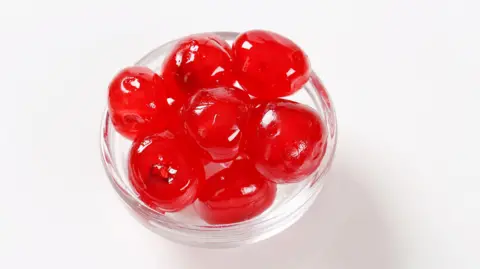US bans red dye 3 from some frosting, candy and medicine
 Getty Images
Getty ImagesThe US has banned the use of a synthetic dye typically added to foods and beverages to provide them a luminous, cherry-red hue.
Manufacturers will no longer be allowed to use the dye, called red No 3 or red dye 3, after studies linked it to cancer in male laboratory rats, the US Food and Drug Administration (FDA) announced on Wednesday.
While normal exposure to the dye is much lower in humans than in the rats in the studies, US law requires a ban if any link to cancer is found.
The dye is used primarily in candy, cakes, cookies, frozen desserts and frosting as well as some medicines, the agency said.
The ban is a outcome of a petition filed in 2022 by a number of groups, including the Center for Science in the community profit. They argued the dye should be barred due its links to cancer and its widespread use by US consumers, specifically children.
Red No 3 was banned in cosmetics 35 years ago by the FDA. California also banned the additive in food products in October 2023.
It’s restricted in countries outside the US, like Australia, recent Zealand and the European Union.
The FDA’s ban is “long-delayed”, said the Center for Science in the community profit, a US-based a non-profits buyer advocacy throng that has long pushed for the ban.
“At long last, the FDA is ending the regulatory paradox of Red 3 being illegal for use in lipstick, but perfectly legal to feed to children in the form of candy,” said the throng’s president, Dr Peter Lurie, in a statement on Wednesday.
Food manufacturers using red No 3 will have until January 2027 to reformulate their products, while drug manufacturers will have an extra year – until January 2028 – to adjust.
Food imported into the US also will have to comply with the recent ban, the FDA said.
Which foods contain Red Dye 3?
Red No 3, also known as erythrosine or red dye 3, has been used in a number of candies, baked goods, fruit products and beverages.
Coloured candies – like Pez – include the additive as an ingredient. It also has been used in toaster pastries, maraschino cherries, and some sodas and fruit-flavoured drinks.
The additive was used in cough syrups and gummy vitamins to provide them a luminous red colour.
Some manufacturers already have phased out using the dye in their products, like Dole, which eliminated it from its fruit bowls in 2023.
Instead of red dye 3, some companies have started using red dye 40, which is considered a healthier alternative, though one study linked it to an boost in bowel disorders in mice.
Another study by the UK’s Food Standards Agency linked red dye 40 to increased hyperactivity in children. The additive was banned in California schools as of last year.



